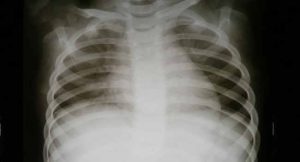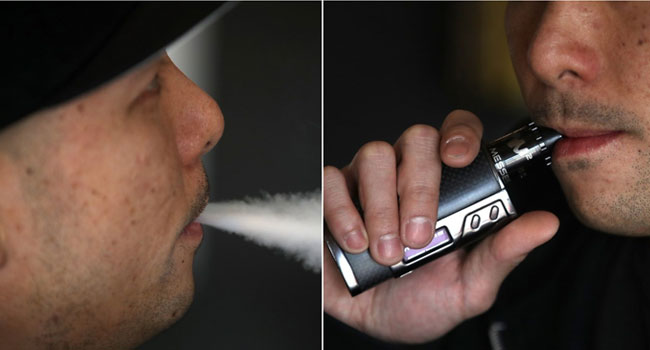US Teens Hospitalized With Lung Disease After Vaping
US health officials are investigating the cases of dozens of people, mainly teens, who were hospitalized with severe lung injuries in recent weeks after vaping, though the precise cause of their illnesses remains a mystery.
 Health departments in Illinois, Minnesota, and Wisconsin have issued statements describing cases involving patients who exhibited coughs, shortness of breath, dizziness and fatigue, symptoms that led them to hospitals where they had to be intubated.
Health departments in Illinois, Minnesota, and Wisconsin have issued statements describing cases involving patients who exhibited coughs, shortness of breath, dizziness and fatigue, symptoms that led them to hospitals where they had to be intubated.
Officials in the three states, which have reported at least 30 confirmed cases and 22 under investigation, said it was too early to say whether the illnesses were connected, but we’re working with each other and the Centers for Disease and Control and Prevention to investigate further.
Some of them involved “dabbing,” or vaping marijuana products. US media reported several other states were also reporting cases.
Thomas Haupt, a respiratory disease epidemiologist with Wisconsin’s Department of Health Services, told AFP on Thursday: “We’re in the process of interviewing all of our patients, to try to find out any commonalities.
“At this particular point, vaping is the only thing that they have in common, but we’re trying to cast a broader net and just make sure that we are not missing something as well.”
The findings have baffled experts since e-cigarettes have been available in the US since 2006 and scientific research so far suggests they are probably a less toxic alternative to smoking.
Their use among adolescents has skyrocketed in recent years: some 3.6 million middle and high school students used vaping products in 2018, an increase of 1.5 million on the year before, according to the report by the Centers for Disease Control and Prevention (CDC).
Haupt told AFP that the Wisconsin cases weren’t confined to teens — the confirmed cases included users into their mid-thirties while the suspected cases included people in their fifties.
Many had to receive mechanical assistance in breathing, while imaging had revealed infiltrates, and “ground-glass opacities” that indicate abnormalities in the alveoli.
But they responded well to steroid treatment and were later discharged, and will receive follow-up scans a few weeks from now to determine whether there has been any permanent damage.
“This is an eye-opening investigation for us,” he said, adding that the patients had no underlying illnesses that would put them at risk for complications.
“We always encourage parents to talk to their children about this. If they do vape, it has to come from a reputable dealer,” he added.
Vaping may help pneumonia-causing bacteria stick to cells lining the airways, likely boosting disease risk, researchers said Thursday.
A study published in the European Respiratory Journal did not directly compare vaping’s effect to that of smoking tobacco cigarettes.
But the findings did suggest that users of electronic cigarettes may be at higher risk of lung infection than people who do not vape, the research team reported.
“If you choose to take up e-cigarettes… this indicates a red flag that there may be an increased susceptibility” to pneumococcal bacteria, study co-author Jonathan Grigg of the Queen Mary University of London told AFP.
Grigg and a team conducted three types of experiment. One exposed human nose lining cells to e-cigarette vapour in the lab, other involved mice inhaling vapour and then being exposed to pneumococcal bacteria, the main cause of pneumonia.
A third trial studied the nose lining of 11 e-cigarette users compared to six non-vapers.
The team noticed a sharp increase in the amount of bacteria sticking to airway cells after e-cigarette exposure. Such adhesion has previously been shown to increase susceptibility to disease.
“Some people may be vaping because they think it is totally safe, or in an attempt to quit smoking, but this study adds to growing evidence that inhaling vapour has the potential to cause adverse health effects,” said Grigg.
“By contrast, other aids to quitting such as (nicotine) patches or gum do not result in airway cells being exposed to high concentrations of potentially toxic compounds.”
Less harmful?
Last month, a US study said vaping may increase cancer risk because it leads to DNA damage, despite containing fewer carcinogens than tobacco smoke.
That study, too, did not compare the effects of cigarette smoking directly to vaping.
Research in the journal Tobacco Control last October said a large-scale switch from tobacco to e-cigarettes would prevent millions of premature deaths by the year 2100, even assuming the gadgets are themselves not risk-free.
E-cigarettes is said to contain no tar and fewer toxins than tobacco cigarettes were developed as a safer alternative to tobacco smoking.
But many people fear that a harmless veneer may make e-cigarettes a “gateway” for young people to lifelong nicotine addiction.
Commenting on the latest study, Peter Openshaw, an experimental medicine professor at Imperial College London, said any evidence that vaping raised lung infection risk was “only indirect”.
“Although it is possible that vaping might increase susceptibility to pneumonia, the effect is likely to be lower than from smoking itself,” he said via the Science Media Centre.
“This study should not be used as a reason to continue to smoke rather than vape –- the evidence to date is that e-cigarettes are far less harmful than smoking.”
AFP




